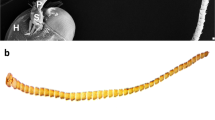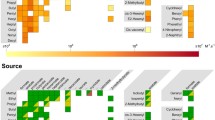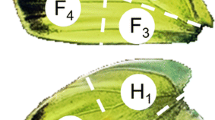Abstract
In insect antennal extracts, Schleicher et al.1 showed that protein kinase C (PKC) inhibitors abolish the transience of pheromone-induced rapid inositol trisphosphate responses, which suggests that pheromonal signals act on phosphorylation of specific proteins. To confirm this hypothesis, we studied the effects of second messengers and a pheromonal blend on phosphorylation of antennal proteins in the cockroachPeriplaneta americana. Proteins from adult male antennae were phosphorylated in vitro in the presence of [γ32P] triphosphate, then separated by SDS-polyacrylamide gel electrophoresis. Numerous phosphopolypeptides were visualized. The presence of Ca++/calmodulin in the incubation medium resulted in increased phosphorylation of polypeptides with molecular weights of 38, 48, 51, 54 and 58 kDa. Stimulation of PKC by addition of Ca++ phosphatidylserine (PS)/phorbol myristate acetate (PMA) resulted in the appearance of three phosphopolypeptides of 36, 70 and 120 kDa. In the presence of cyclic adenosine monophosphate, two new major polypeptides of 46 and 42 kDa appeared; the latter polypeptide also appeared in the presence of cyclic guanosine monophosphate. Comparison with polypeptide composition of tissue from the cerci, leg, brain and fat body showed that the 36 and 48 kDa polypeptides were specific to antennae, whereas the 120 kDa polypeptide was also present in the adult brain. When antennae are subjected to pheromonal stimulation for 16 seconds prior to homogenization, in vitro phosphorylation of the 120, 70, 64 and 38 kDa polypeptides was inhibited, whereas phosphorylation of the 58, 54, 51 and 48 kDa polypeptides was strongly stimulated. It is noteworthy that a 107 kDa polypeptide was observed only after pheromonal stimulation by Ca++/PS/PMA. Our findings suggest that Ca++-and PKC-dependent protein phosphorylation systems play an important role in the transduction of pheromonal signals in antennae of male cockroachP. americana. We speculate that specific phosphoproteins may modulate sensitivity and signal amplification during the olfactory transduction process.
Similar content being viewed by others
References
Schleicher, S., Boekhoff, I., Konietzko, U., and Breer, H., J. Comp. Physiol. B164 (1994) 76.
Ache, B. W., Seminars in “Cell Biology”5 (1994) 55.
Breer, H., Cell Biology5 (1994) 25.
Boekhoff, I., Michel, W. C., Breer, H., and Ache, B. W., J. Neurosci.14 (1994) 3304.
Hatt, H., and Ache, B. W., Proc. Natl Acad. Sci. USA91 (1994) 6264.
Breer, H., Boekhoff, I., Strotmann, J., Raming, K., and Tareilus, E., in: Information Processing of Chemical Sensory Stimuli in Biological and Artificial Systems, p. 77. Ed. D. Schild, Springer, Berlin 1989.
Boekhoff, I., Strotmann, J., Raming, K., Tareilus, E., and Breer, H., Cell. Signal.2 (1990) 49.
Boekhoff, I., Seifert, E., Göggerle, S., Lindemann, M., Krüger, B.-W., and Breer, H., Insect Biochem. Molec. Biol.23 (1993) 757.
Breer, H., Raming, K., and Boekhoff, I., Naturwissenschaften75 (1988) 627.
Boekhoff, I., Raming, K., and Breer, H., J. Comp. Physiol. B160 (1990) 99.
Ziegelberger, G., van der Berg, M. J., Kaissling, K. E., Klumpp, S., and Schultz, J. E., J. Neurosc.10 (1990) 1217.
Zufall, F., and Hatt, H., Proc. Natl Acad. Sci. USA88 (1991) 8520.
Zufall, F., Firestein, S., and Shepherd, G. M., Annu. Rev. Biophys. Biomol. Struct.23 (1994) 577.
Shirsat, N., and Siddiqi, O., Current Opinion in Neurobiology3 (1993) 553.
Breer, H., and Shepherd, G. M., TINS16 (1993) 5.
Walaas, S. I., and Greengard, P., Pharmacol. Rev.43 (1991). 299.
Hawkins, W. A., and Rust, M. K., J. Chem. Ecol.3 (1977) 85.
Saas, H., J. Comp. Physiol.152 (1983) 309.
Bradford, H. M., Anal. Biochem.65 (1976) 248.
Laemmli, U. K., Nature227 (1970) 680.
Parmentier, M., Vanderhaeghen, P., Schurmans, S., Libert, F., and Vassart, G., M/S10 (1994) 1083.
Breer, H., J. Steroid Biochem. Molec. Biol.29 (1991) 621.
Kaissling, K.-E., and Boekhoff, I., in: Sensory Systems of Arthropods, p. 489. Eds K. Wieser, F. G. Gribakin, A. V. Popov and G. Renninger. Birkhäuser Verlag, Basel 1993.
Michel, W. C., and Ache, B. W., J. Neurosc.12 (1992) 3979.
Krieger, J., Gänble, H., Raming, K., and Breer, H., Insect Biochem. Molec. Biol.23 (1993) 449.
Vogt, R. G., Riddiford, L. M., and Prestwich, G. D., Proc. Natl. Acad. Sci. USA82 (1985) 8827.
Degrelle, F., Tirard, A., Strambi C., Renucci, M., and Strambi, A., J. Insect Physiol.40 (1994) 293.
Hesse, J., and Marmé, D., Insect Biochem.15 (1985) 835.
Kelly, L. E., Comp. Biochem. Physiol.69B (1981) 61.
Author information
Authors and Affiliations
Corresponding author
Rights and permissions
About this article
Cite this article
Renucci, M., Tirard, A., Sreng, L. et al. Phosphorylation of cockroach antennal polypeptides: effects of second messengers and pheromonal blend. Experientia 52, 762–768 (1996). https://doi.org/10.1007/BF01923986
Received:
Accepted:
Issue Date:
DOI: https://doi.org/10.1007/BF01923986




